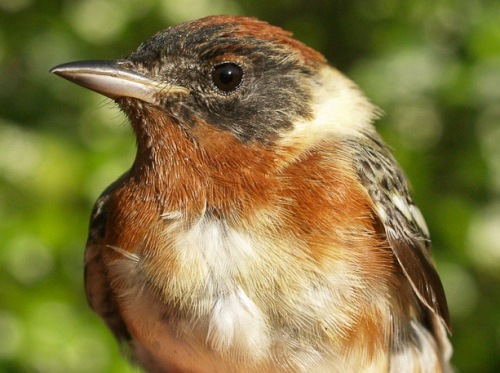|
|
THIS WEEK |
THIS SPRING |
2012 TOTAL |
SITE TOTAL |
# birds (and species) banded |
202 (32) |
738 (60) |
813 (61) |
36564 (108) |
# birds (and species) repeat |
64 (17) |
216 (26) |
230 (29) |
6643 (69) |
|
# birds (and species) return |
12 (6) |
89 (14) |
115 (15) |
1076 (38) |
|
# species observed |
95 |
135 |
136 |
205 |
|
# net hours |
480.0 |
2090.0 |
2153.8 |
61252.9 |
|
# birds banded / 100 net hours |
40.6 |
35.3 |
37.7 |
59.7 |
|
|
Note: table does not include nocturnal banding (owls) |
Banders-in-charge: Simon Duval, Gay Gruner
Assistants: Christine Barrie, Nicolas Bernier, Cindy Bouchard, David Davey, Rui De Jesus, Leah den Besten, Réjean Duval, Barbara Frei, Louise Gagné, Alison Hackney, James Junda, Lisa Keelty, Barbara MacDuff, Francine Marcoux, Betsy McFarlane, Scott Pemberton, Lisa Rosenberger, Catherine Russell, Marilou Skelling, Jane Sorensen, Patricia Stotland, Jay VanderGaast, Yifu Wang
Notes: Although the final day of the week was completely rained out, we were able to operate full hours on all other days, and overall our totals were only slightly lower than last week. We banded just over 200 more birds, bringing the season total to 738, far ahead of the previous record pace of 622 at this stage of the season. Our 216 repeats for the season are also well above average thanks to a substantial boost this week, reflecting that a good number of birds stayed around for at least a day or two before continuing on their way (or in some cases, settling down at MBO for the summer). The 89 returns so far this spring is also near record pace, showing good overwinter survival by òur`birds. Again this week the number of species observed was in the mid-90s and the season total of 135 is above our long-term average at this point in spring. Aside from our rainy day, daily counts were consistently good, ranging from 52 to 65 species.
It is worth noting though that even though numbers are good overall this spring, that does not mean trends are positive for all species. Of particular concern is a sharp decline this year in the number of Cliff Swallows observed, reflected not only in those observed feeding around Stoneycroft Pond, but also through follow-up checks at the nearby breeding colony. A wide variety of aerial insectivores have suffered significant declines in recent years; to date Cliff Swallows have not been highlighted, but perhaps this is a warning sign that they are not immune to the broader trend.

On May 17, we banded an impressive 22 Tennessee Warblers - 6 of which we had at the same time. Whenever we get many individuals of a particular species, there is a better chance of finding one or two that deviates from the norm a bit. This week we had a second-year male Tennessee Warbler with a distinct hint of rust on its crown - something that occasionally occurs on after-second-year males, but supposedly not younger ones.
(Photos by Simon Duval)
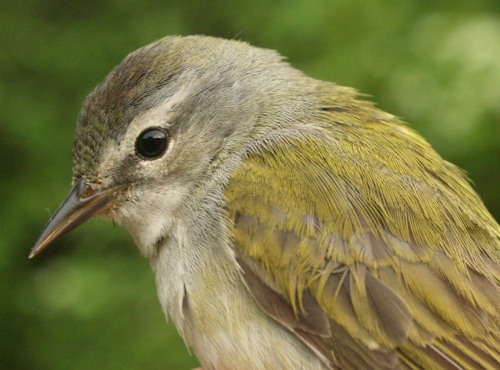
|
At this point in the season, it becomes more difficult to add new species, but there were still half a dozen late arrivals this week. Observed for the first time this year were American Woodcock, Lesser Yellowlegs, Golden-winged Warbler, Orange-crowned Warbler, Mourning Warbler, and Canada Warbler. Two of those warblers (Orange-crowned and Canada) were also among the seven species banded for the first time this spring, along with Hairy Woodpecker, Red-eyed Vireo, Bay-breasted Warbler, Blackpoll Warbler, and Brown-headed Cowbird. Out of that list, only Hairy Woodpecker had been banded earlier in the year during the winter program. The only new addition to our list of species that have returned this year was Purple Finch - more on that bird in this week's closing series of photos.
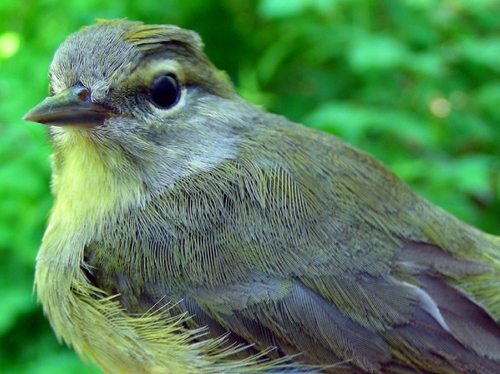
For contrast with the Tennessee Warblers above, here is this week's Orange-crowned Warbler - only our fourth ever banded in spring. Note the more yellow breast.
(Photo by Gay Gruner)
|
Also of note this week was a Golden-crowned Kinglet that had a stiff right wing which appeared to have healed from a previous injury. It was able to fly well and actually had a good level of fat (4 on a scale of 7), demonstrating nicely how well birds can sometimes recover from injuries that might at first glance appear to pose a grave risk to survival.
This week’s
top 10 [last week's rank in brackets]
#
individuals banded |
mean # individuals observed daily |
1. Tennessee Warbler (42) [3] |
1. Red-winged Blackbird (41) [2] |
2. Magnolia Warbler (18) [7] |
2. American Crow (25) [4] |
3. Yellow Warbler (17) [4] |
3. Cedar Waxwing (20) [-] |
3. American Goldfinch (17) [-] |
4. Tennessee Warbler (18) [-] |
5. Northern Waterthrush (15) [9] |
5. Yellow Warbler (16) [5] |
5. Common Yellowthroat (15) [-] |
6. American Goldfinch (13) [-] |
7. Cedar Waxwing (9) [-] |
7. Common Grackle (11) [7] |
7. Red-winged Blackbird (9) [2] |
8. Tree Swallow (10) [-] |
9. Gray Catbird (7) [9] |
8. Black-capped Chickadee (10) [10] |
10. American Redstart (5) [-] |
8. Baltimore Oriole (10) [6] |
10. Common Grackle (5) [-] |
|
|
Week 8 is traditionally when the big wave of warblers reaches MBO, and this year it was particularly true. For just the second time in eight years, the top three species banded in week 8 were all warblers - and there were another three species in the rest of the top ten. Tennessee Warbler took top place, as it did in this week in 2009, but this time by a large margin, with more than twice as many as the runner-up Magnolia Warbler (which in turn has never before ranked this high in spring, although it routinely tops the list for at least a few weeks each fall). We had another good movement of Yellow Warblers this week, with the total of 30 over the past two weeks matching the spring 2011 season total. American Goldfinch came out of nowhere to tie for third place. Rounding out the top five were two more of the warblers, Northern Waterthrush and Common Yellowthroat. Not surprisingly, Red-winged Blackbirds are tapering off, but the 9 extra individuals this week increased their season-leading total to 112. Also of note, the 7 Gray Catbirds this week is a good count, given that spring season totals have ranged from 9 to 15. Overall, there was a fair amount of turnover this week, with seven species dropping off from last week's list, including three that were in a last-place tie (Warbling Vireo, Lincoln's Sparrow, and Baltimore Oriole), three others in the bottom half of the list that are early to mid-season migrants (Ruby-crowned Kinglet, Nashville Warbler, and White-crowned Sparrow), and most notably Yellow-rumped Warbler, which topped last week's list with 41 banded, but largely cleared out, with only 2 more this week.
A similar change occurred on the list of species observed, with Canada Goose dropping from top spot last week with a mean daily count of 128 individuals to way out of the top ten this week with just 2 per day on average! Drastic as this seems, it's in line with the usual pattern of the last migrant flocks moving on and just a local pair or two remaining - it's just that the transition occurred later than ever this year. Returning to top spot this week was Red-winged Blackbird, which has also been the most abundant species in week 9 in four of seven previous years. The other three years, Ring-billed Gull was number one - but this week it was relatively scarce, actually landing just outside the top ten. In between were mostly species that are local residents, although of course some individuals likely are migrants moving through as well. The notable exception was Tennessee Warbler, which does not breed at MBO - and which has never before had such a high daily mean count in spring.
Two weeks remain in this year's Spring Migration Monitoring Program, and just ten days of banding. We have had an excellent season so far and are on pace to break several records if weather and migration remain good. Stay tuned for the final two updates of the season!
|
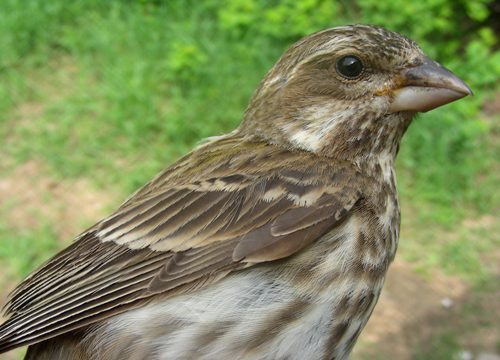
The photo above was taken on May 20, 2007, when we first banded this Purple Finch, which we identified at the time as sex unknown and after-hatch-year, although we suspected it was a second-year bird (we weren't willing to guess at sex!)
(Photo by Marie-Anne Hudson)
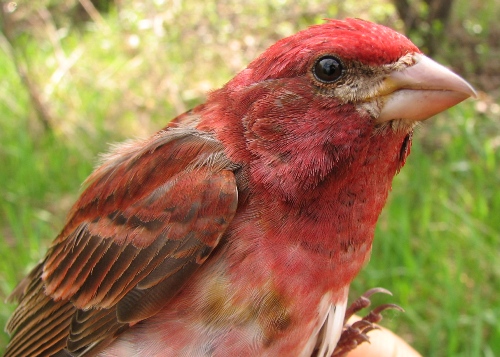
One year and 8 days later, we recaptured the same bird - now clearly a male! Working backward, we could therefore conclude our initial hunch was right, and it was a second-year bird in 2007. Interestingly, there were still some brown patches visible in May 2008, suggesting that in some cases like this, Purple Finches (males at least) may be aged as third-year based on plumage.
(Photo by Barbara Frei)
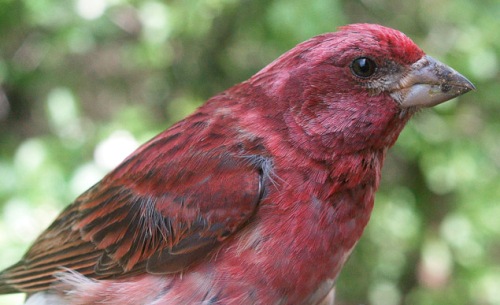
Finally, here is the same bird again, just two days shy of its five-year anniversary of banding, and now in its sixth year. Note the more uniform and deeper purple plumage, compared to the third-year photo above. Perhaps the most peculiar aspect of all this is that despite this bird clearly returning to MBO most years, we have no summer records of the species on site, so either it is an awfully secretive breeder, or perhaps it is stopping in at MBO upon arrival, and then shifting over to nest in the Morgan Arboretum.
(Photo by Simon Duval)
|

